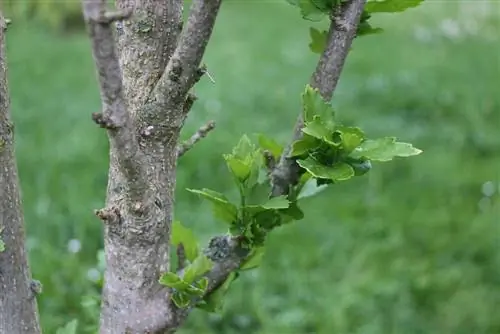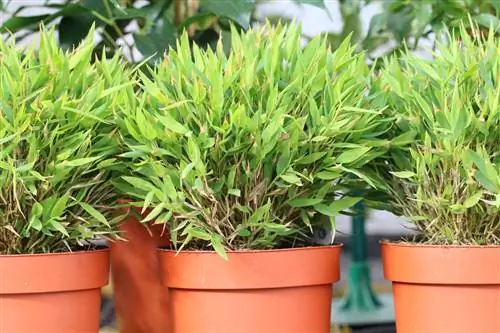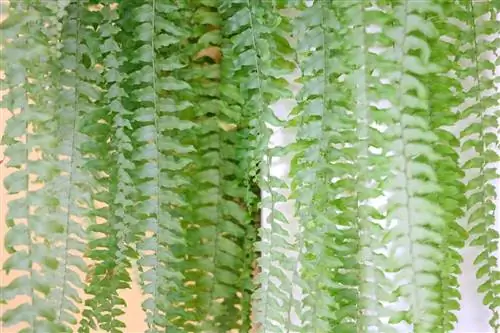- Author admin [email protected].
- Public 2023-12-17 03:39.
- Last modified 2025-01-24 12:45.
If you own a hibiscus, you can enjoy its magnificent flowers for many years if you take good care of it. Optimal care also includes plant pruning. This forms the basic requirement for a dense foliage, many flowers and he althy growth. The shape is also determined by shortening the branches. In some cases, a radical cut is even necessary. The following instructions describe in detail when you should proceed and how to cut.
Time
You can prune the indoor hibiscus in autumn or spring. The optimal times are September/October and March/April. The prerequisite is that the indoor hibiscus is not exposed to cold. This means that if the plant moves to cooler winter quarters in the fall, the cutting must be done around two weeks beforehand.
In early spring, the indoor hibiscus should have been removed from its winter quarters before cutting is carried out. Room temperatures between 20 degrees Celsius and 22 degrees Celsius are optimal. Shortening once a year is completely sufficient.
Cutting tool
The indoor hibiscus should only be cut with suitable cutting tools. The “Humken” from the kitchen or the children’s craft scissors are absolutely not suitable for this. It is recommended to buy special plant scissors, which are available from specialist retailers for little money and in a wide range of sizes. Alternatively, you can also use a knife that has a smooth blade. However, you should only use this for this purpose and not switch it between cutting roasts and cutting plants.
Cutting hygiene
A very important point when cutting an indoor hibiscus is the hygiene of the cutting tool. In countless cases, dangerous viruses, bacteria or other diseases get onto and into the plant through this. For this reason, it is extremely important that cutting tools are professionally disinfected after or before each use. Flowers or branches should never be cut without disinfection.
You can choose from various disinfection methods:
Heating
You can carefully disinfect knife and scissor cuttings with a gas burner or lit spirit. To do this, hold the blades/cutters deep into the flame for a few seconds. The deeper it is guided, the hotter the temperature and the more intensively the disinfection of the cutting tool occurs. Of course, caution is advised to ensure that no skin burns occur or that flammable/flammable parts of the cutting tool do not melt or catch fire.
Alcohol
One of the most common methods of disinfection is using alcohol. Regular 70 percent isopropanol, which is also used for medical skin disinfection, is suitable for this. This is available in pharmacies, drugstores and well-stocked supermarkets. Alcohol offers an alternative. This is mixed with distilled water to form a 70 percent spirit solution. 0 percent alcohol is also available, but costs significantly more in comparison.

Disinfection is done by placing the cutting tool in the solution/isopropanol. Leave it submerged there for around two minutes. Make sure that the cutting edges/blades in particular are completely covered with the liquid. It is ideal if the handle is also disinfected. This means that when you touch the handle and then touch the blades, you cannot transfer germs back to the blades/cutting edges. After the immersion time has elapsed, simply allow the liquid to air dry. To do this, place the cutting tool on a clean cloth or, better yet, on kitchen paper.
Chemical disinfection
If you want to be on the safe side, you can use chemical disinfectants. These work very effectively and reliably against bacteria, germs, viruses and many other pathogens. The manufacturer BAYER, for example, offers the five percent solution “Dimanin”. Here the cutting tool is either completely submerged or the blades/cutting edges are wiped with a clean cloth. The latter is particularly advantageous if you want to shorten other plants after cutting your indoor hibiscus. By wiping and chemical disinfection, you can easily prevent the possible transmission of bacteria and viruses to subsequent plants. Disinfection is also done quickly after cutting and the tool can be stored clean.
Cutting technique
When cutting off indoor hibiscus branches and/or trunks, it is particularly important how they are cut. A straight cut should be avoided here. An oblique cut is advisable. This keeps the cut surface smaller than a straight cut. In addition, a diagonal cut allows water to drain better if you water or spray your indoor hibiscus from above. As a result, this means that the interface can dry more quickly, thereby reducing the chance of bacteria, viruses or other pathogens entering.
After the cut
If you want to prune your indoor hibiscus in the fall and then leave it to overwinter in a cool place, you should treat the cuts. In autumn, the humidity usually rises extremely and the cool temperature in the winter quarters slows down the drying of the cuts. This in turn means that they remain open for a long time and the chance of bacteria, viruses and other pathogens penetrating them is significantly increased. Here you can take intelligent precautions by disinfecting and/or sealing the interfaces.
If pruned in spring or without overwintering in a cooler place, follow-up treatment is not absolutely necessary. If the hibiscus is exposed to warm room temperature, the cut areas usually dry very quickly. However, disinfection does not harm the plant.
You can choose from the following options for disinfection and sealing:
- Resin and wax for sealing
- Cinnamon and charcoal powder for disinfection
- Zinc dust disinfects and seals at the same time
Tip:
Perform a seal immediately after sectioning. If you wait too long, bacteria or viruses could have already penetrated and by sealing you deprive the plant of any opportunity to push it out again using its own strength.
Cutting types

In order to give the indoor hibiscus a suitable cut, different types of cuts are available. These mainly relate to shape and growth capacity. But even in the event of a life-threatening illness or a parasite infestation, a special type of cut can save the life of your indoor hibiscus.
Educational Cut
The training pruning is a type of pruning that is mainly used on young indoor hibiscuses. This is also known as a growth cut and is used to help the young plants, which usually have few shoots, gain more volume and density. The training cut is usually done in the fall, but can be done in the spring if it was forgotten in the fall. When it comes to parenting, proceed as follows:
- Cut off all shoots and the trunk by three quarters
- Cut cross-growing branches directly at the junction
- Pruning duration: during the first three years of life or until dense growth can be seen
High trunk pruning
The hibiscus is very popular and decorative as a standard plant. Since they are usually significantly more expensive to buy than conventional hibiscuses, it is worth tackling the standard pruning of young plants yourself with the right pruning. However, you will need a little patience because the standard hibiscus is usually only “ready” after four or five years. This is what the optimal standard cut looks like:
In the first year of life
- Short all side branches except for two or three buds
- The trunk is not cut
In the following years of life
- Short all branches so much that two or three buds remain
- Short the leading shoot to five or six eyes
Final cut
- Cut off heavily developed branches except for one or two eyes
- Give the crown a shape cut if necessary
Tip:
The hibiscus variety “Blue Bird” is particularly suitable for standard growth because it grows quickly and can be optimally guided by the special cut.
Conservation cut

The indoor hibiscus needs the so-called maintenance cut as an adult plant at the latest. Old branches are removed and space is made for new shoots. The maintenance cut ensures that a dense foliage remains, the plant continues to grow vigorously and numerous flowers appear every year.
This type of cut is carried out once a year as follows:
- Cut off dry and diseased branches
- Sever soft or weak-looking branches above three or four eyes
- Cut branches that protrude too much on one side at the deepest branching
Rejuvenation cut
With increasing age, the number of light spots in indoor hibiscuses usually increases. If you want to avoid this or close any gaps, then the so-called rejuvenation cut is the right choice. Apart from the appearance, the dried branches unnecessarily drain the nutrient reserves and thereby reduce the nutrient supply for new shoots and the growth of flowers. This means that a rejuvenation cut should be carried out every few years at the latest.
The procedure depends on the plant density:
- If there is severe thinning, at least two thirds of the branches and the main trunk should be cut back
- With normal thinning, a pruning of a third as well as a section of withered and cross-growing branches is sufficient
- During the preventive clearing cut, only dried branches are cut out
Radical cut
In some cases you will not be able to avoid having to make a radical cut. This can be the case, for example, if your hibiscus has been severely damaged by a disease such as a fungal infection or a parasite simply cannot be fought quickly enough. Even if there is severe root rot and the roots have to be pruned, a radical cut is usually essential so that the damp branches and trunks do not start to mold and the plant regains its strength to sprout again. However, there is no guarantee that the hibiscus will recover after illness or a pest infestation.
However, depending on the severity, the chances are very good. However, when making radical cuts due to diseases or pests, you proceed differently than when making radical cuts, which are intended to give the plant new energy for improved growth. The radical cut for diseases and pests is carried out as follows:
- Cut off all branches completely except for the lowest branches
- Short the main trunk to just above the first branches above the earth's surface
Radical cut for improved growth:
- Delay the process for at least two years, better for three to four years
- Cut back two thirds first year
- Subsequent years each a little more than the year before
- Pruning is done when the main trunk with the first branches is approximately five centimeters above the ground surface
- The parenting cut will then be applied in the following year
Tip:
If a radical cut is to be carried out due to illness or pest infestation, this must be done quickly. In this case, you should not wait for the optimal cutting times of autumn and spring.






